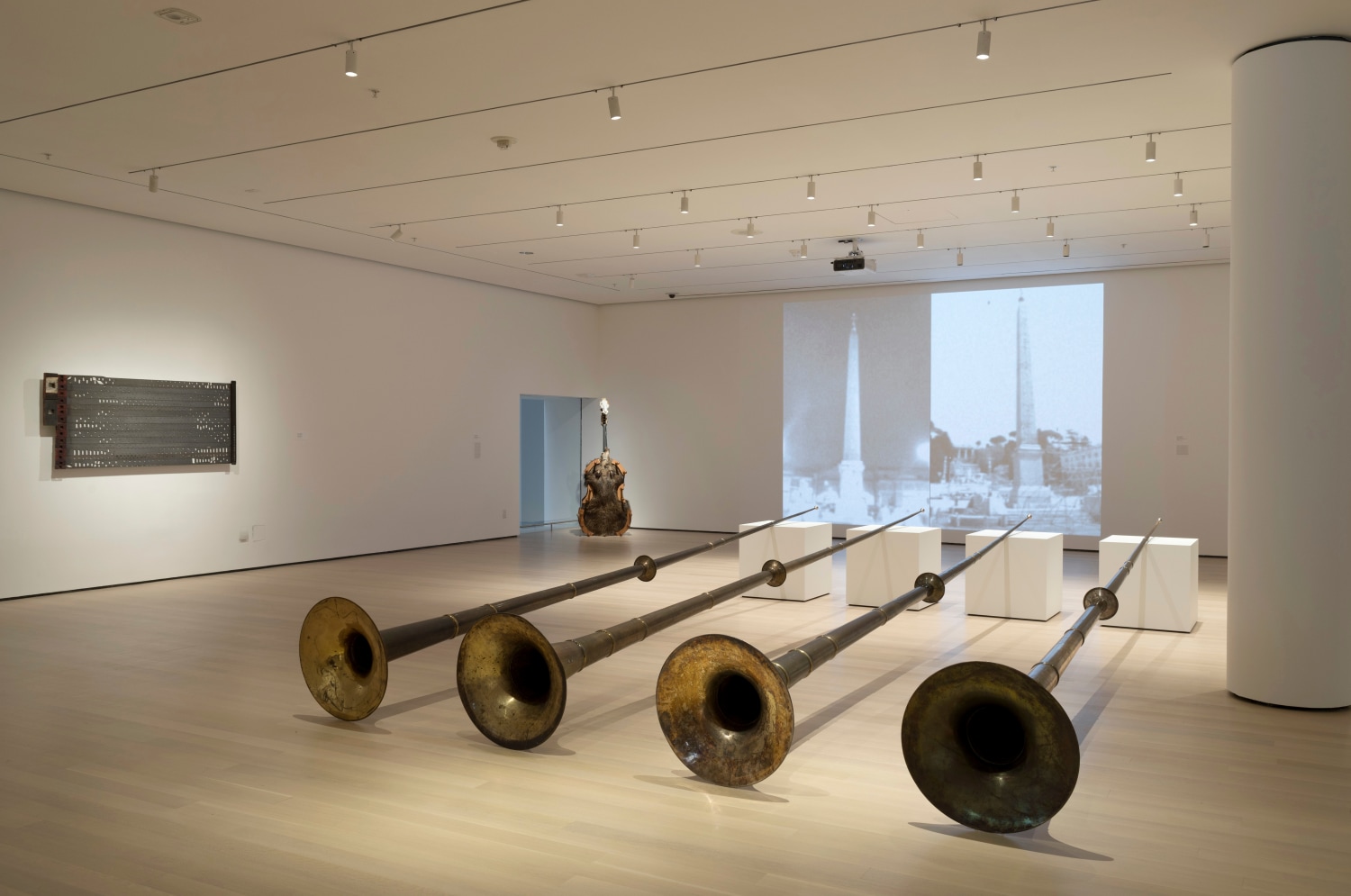
My quest has been to find a way to make music as physical as sculpture might be, and sculpture as ethereal as music is. –– Terry Adkins
Terry Adkins was a thoughtful and rigorous artist and teacher who demonstrated a deep commitment to the interdisciplinary throughout his career. His work as a sculptor, musician, filmmaker, printmaker, and orchestrator of installations and experiences remains hugely influential and widely acclaimed. Paula Cooper Gallery looks forward to further advancing this impact in collaboration with the Estate of Terry Adkins, beginning with the gallery’s first exhibition of the artist in April 2022. Thomas Dane Gallery will continue to represent the Estate of Terry Adkins in Europe.
Beginning in the early 1980s, Adkins produced enigmatic sculpture from salvaged materials imbued with social and historical significance by their previous users. The works reference minimalism in their symmetry, manufactured forms, and remarkable elegance, while their jagged patinas reveal the past lives of the distinct parts. Adkins considered his re-purposing of selected materials to be a continuation of their ongoing acquisition of cultural meaning, and he would physically and conceptually transform existing works for new sites and circumstances. Concurrent to his work as a visual artist, Adkins was a talented saxophonist who made improvisational, jazz-inflected music, and his art reveals the influence of music in its structure, composition and rhythm, particularly in his video work. The use of salvaged instruments and the forging of new, unusual, playable sculptures is a hallmark of the artist’s practice.
Adkins was inspired by the African tradition of situating a sculpture in a society permeated with music, and his expansive and deeply intellectual approach to artmaking coalesced in his “recitals.” Loosely defined as an activation or rejuvenation of an installation of artworks through a combination of film, music, and readings, the recitals challenged audiences to replace audio or visual encounters with an overall sensory experience. The installations, performances, and the individual works contained therein were investigations into the lives of historical figures in African-American history such as Beethoven, the nineteenth-century abolitionist John Brown, and Arctic explorer Matthew Henson. Considering the creation of purely abstract work to be insufficient, Adkins conceived of his recitals as alternative portraits of his chosen subjects, part of “an ongoing quest to reinsert the legacies of unheralded immortal figures to their rightful place within the panorama of history.”[1]
At Paula Cooper Gallery, the Estate of Terry Adkins joins a roster of artists similarly devoted to the integration of art and music and a gallery dedicated to presenting music and performance in the presence of works of art. Paula Cooper Gallery presented Jupiter (1994), an early assemblage of wood and enamel, at Art Basel in September 2021, and will present a selection of works at Art Basel Miami Beach in December 2021. Alexis Johnson, Partner, worked with the Estate of Terry Adkins at Lévy Gorvy Gallery, where an exhibition of Adkins’s work curated by Charles Gaines took place in 2018.
It is my profound pleasure to continue collaborating with the Estate of Terry Adkins and to bring the artist’s complex and groundbreaking work to a wider audience. –– Alexis Johnson, Partner, Paula Cooper Gallery
Terry Adkins (1953–2014, b. Washington, D.C., d. Brooklyn, NY) grew up in Alexandria, Virginia, and studied printmaking at Fisk University, Nashville, and Illinois State University, Normal, before receiving an MFA in sculpture from the University of Kentucky, Lexington. Adkins arrived in New York in 1982 to be an artist in residence at the Studio Museum in Harlem, which was followed by a residency at PS1 in Queens. In 1986 Adkins moved to Zurich as part of an artist exchange between PS1 and Binz 39, a similar organization, and remained in Switzerland for two years, where his work was a critical and commercial success. While in Zurich, Adkins founded the Lone Wolf Recital Corps, a revolving group of performers trained across disciplines that would continue to enact his recitals throughout and beyond his lifetime. From 2000 until his death, Adkins was a Professor at the University of Pennsylvania, where he became a mentor to many former students who in turn performed in his recitals.
In 2012, Ian Berry curated Recital, a 30-year retrospective of Adkins’s work at the Frances Tang Teaching Museum at Skidmore College, NY, that travelled to the Block Museum of Art at Northwestern University, IL, and was followed by a comprehensive catalogue in 2017. In the years following Recital, the significance of Adkins’s work began to be more widely recognized: in 2012 his monumental sculpture The Last Trumpet was included in the Performa Biennial, in 2014 he was selected for the Whitney Biennial for which he made Aviarium, and in 2015 Okwui Enwezor included Adkins’s work in the Venice Biennale. In 2016 the University Galleries at Illinois State University organized an exhibition of Adkins’s video art, and MoMA restaged performances by the Lone Wolf Recital Corps. Exhibitions of Adkins’s work organized posthumously include the one-person exhibition Infinity is Always Less Than One at the ICA Miami in 2018, and the Pulitzer Arts Foundation’s Resounding, focusing on the artist’s early sculpture. In 2020, Fisk University and the Frist Museum in Nashville also organized exhibitions dedicated to aspects of Adkins’s work.
Work by Terry Adkins is in the collections of The Museum of Modern Art, The Whitney Museum of American Art, The Metropolitan Museum of Art, and The Studio Museum, in New York; The Smithsonian Institute, Washington D.C., The San Francisco Museum of Modern Art and The Museum of Fine Arts San Francisco; The Museum of Contemporary Art, Los Angeles; The Museum of Contemporary Art, Chicago, and the Tate Collection, UK, among others, and private collections worldwide.
[1] Terry Adkins in Among Others: Blackness at MoMA, ed. Darby English and Charlotte Barat (New York: The Museum of Modern Art, 2019).